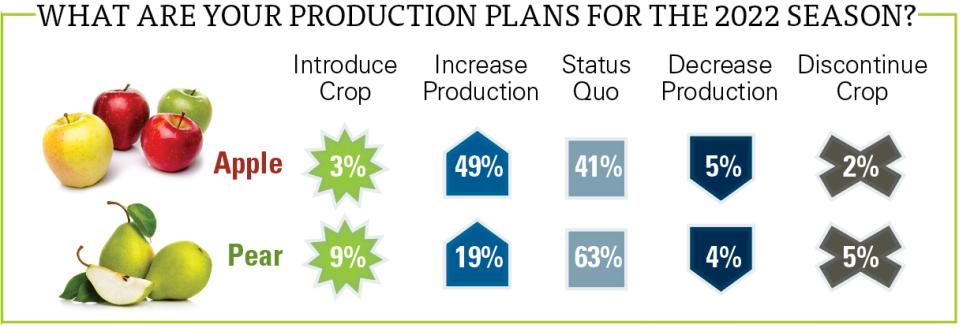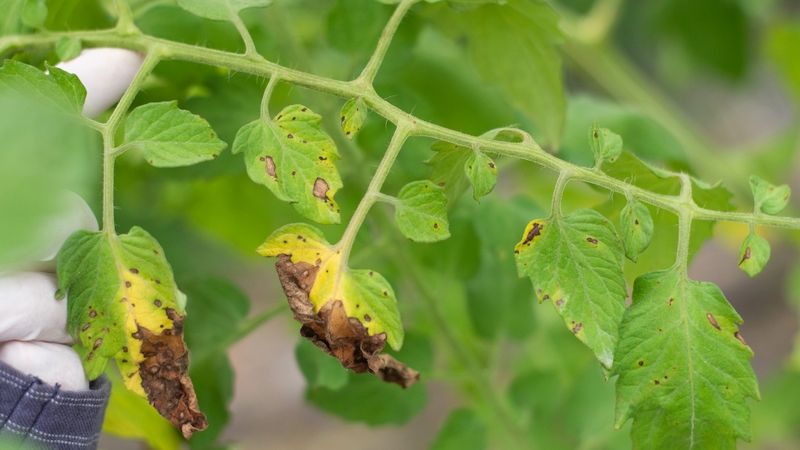How American Pome Fruit Growers are Moving Forward in 2022
Barring the unimaginable (such as an unprecedented heat dome?), many U.S. pome growers figured the 2021 season could not be any worse than the previous year.
“We had a freeze on Oct 27, 2020, that was comparable to the Armistice Day storm of 1940, which destroyed the Iowa apple industry,” a Colorado grower says.
“We had devastating frost damage that destroyed 99% of our crop,” an Indiana grower laments about 2020.
And then there was the dawn of a pandemic.
“It was a very discouraging year,” a California grower says. “We had a very difficult situation with the COVID lockdowns and labor to pick our crop. We had to leave a lot of fruit on the trees.”
So, 2021 could only get better. Right? Well, not exactly. According to American Fruit Grower’s annual State of the Industry survey, 43% of pome growers improved their production in 2021 while 41.5% suffered declines.
At blame for much of the shortfall is the heat wave that overwhelmed the Pacific Northwest (PNW) last summer.
“Yields would have been greater, but the heat dome impacted 2021 crops,” a Washington state grower/packer says.
For example, ‘Gala’ apples in the PNW were misshapen because of the triple-digit heat and in some cases were not harvested, a Washington grower says.
“The unusually hot weather early in the growing season slowed fruit growth,” another Washingtonian says. “Individual apple size at harvest was smaller than normal, although pears thrived in the heat and were larger than normal.”
FIRE AND ICE
Just as detrimental last season were early and late-season freezes, according to growers from Montana to New Mexico, Georgia to New York state, and everywhere in between.
“The 2021 bloom was very early,” a Wisconsin grower says. “We had 13 freezing events while blooming.”
In Georgia, a grower cites a “devastating” freeze that left less than 10% of his apple crop intact while wiping out all of his peaches and blueberries.
Of course, the weather was not so bad elsewhere. “Good weather helped our Bud 9 rootstock ‘Honeycrisp’ trees become healthier and produce more apples,” a Wisconsin grower says. “Production was up almost 50% even after 1,700 out of 4,300 were replaced last year.”

SUCCESS STORIES
A grower in Connecticut, who, after experiencing one his smallest apple crops in 2020, says he enjoyed one of his biggest crops in 2021. While many fared poorly last year, he was not alone in such accomplishment.
What worked well for some pome growers? For starters, sprays of all sorts did wonders. In the PNW, apple growers applied sun protectants to prevent sunburn inflicted by the heat dome.
“We handled heat stress through evaporative cooling, netting, and sun protectant sprays,” a Washington grower says.
Water was applied in emergency as well. “We cool our fruit with overhead irrigation when the temperature reaches a certain threshold,” a Washington grower says.
“The heat was hard on the crop,” an Oregon grower adds. How hard? “We used sprinklers as often as possible. We do not have overhead sprinklers, though.”
On the pest front, growers from Washington state down to Northern California frequently found themselves having to spray against a familiar insect and disease.
“Codling moth and fire blight — timely sprays provided good control,” a Washington grower says.
“The heat itself seemed to exacerbate conditions for pests, such as codling moth, to thrive more than usual,” an Oregon grower notes.
“Unseasonable rains made for extra blight sprays in the spring,” a California grower adds.
On the other side of the country, in Connecticut, a grower/packer “kept a tight fungicide program” when the wet summer created more disease pressure.
Finally, in New Jersey, growing the apples was not a problem. Selling them was. “We had more fruit on the trees, but we’re a U-pick operation, and sales were down from 2020,” the grower says. “We ended up donating more than 100,000 pounds of fruit last year.”
Patience Is a Virtue — Especially for Those Wh0 Grow Pears
Many pear growers see a bright future for their industry. Others simply cannot wait that long.
Responses to American Fruit Grower’s annual State of the Industry survey run the gamut regarding pears. For every two growers who are introducing the crop this season, there is one who is discontinuing it.
“We are just getting started growing pears,” an Indiana grower says, noting that he will direct market all of them.
“We just removed all our pears,” counters a New York grower.
“Production is very difficult to sustain,” a Washington state grower explains. The future, he says, is “dismal.”
So why the optimism? Why are 9% of pear growers initiating the crop in 2022 and another 20% increasing production?
“We are a few years out from some exciting changes,” a Washington grower says. “Pear is the next tree fruit to go through the rootstock change and hopefully varietal change. However, it will not be cheap. With varietal change, it will be in a club format, which will exclude many growers until the universities in the Northwest ramp up the breeding program, which would, in principle, be more equitable than the private breeders.”
A fellow Washington grower/packer desires dwarfing rootstocks that are winter hardy. In New York, a counterpart hopes the new, high-quality varieties will be fire blight resistant.
The arrival of high-density production systems is especially anticipated. “The future is high density and the efficiencies that come with that,” a Washington grower says. “Slow and steady wins the race.”
Nonetheless, according to an Oregon grower/packer, “Unless you are reinvesting in new planting at high density, I think it will be a difficult decade.”
A fellow Oregonian says the region’s future for pears is
good if disease and pests can be controlled. “I introduced a few new varieties to my product mix this past year, and many consumers were willing to try them and provide feedback,” the grower says.
If nothing else, the pear industry has pop culture going for it. “Pear nectar — it’s the flavor in Hawaiian punch that everybody likes,” a Nebraska grower says. “And spicy pickled pears and spicy pear butters are hot.”










